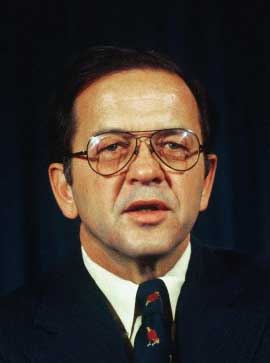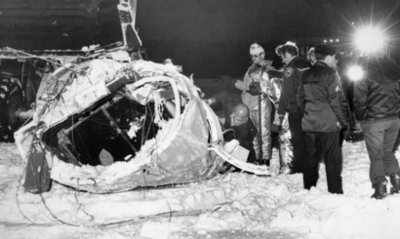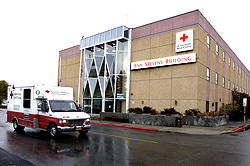Ice Where You Least Need It At Anchorage International Airport, Alaska December 4th, 1978 In the fall of 1978, while discussing a piece of legislation on the floor of the United States Senate, the senior Senator from the State of Alaska, Ted Stevens, mentioned a premonition he had that - like his former colleague congressman Nick Begich had most likely in 1972 - he too were die in a plane crash. Alaska being the largest state in the union, and having so little road infrastructure - traveling by plane is the most common, and most practical, form of transportation throughout the land mass. Statistically, he understood a good chance of being correct - but the date and place was a factor yet to be determined by fate. Theodore Fulton Stevens was born November 18, 1923, in Indianapolis, Indiana, the third of four children. His father, George, was an accountant before the stock market crashed in 1929 - his parents soon divorced and eventually sent him to live with his aunt in Redondo Beach, California. After graduating from high school in 1942, Stevens attended Oregon State University for a semester, studying engineering.  With World War II in progress, he left college to fly with the Army Air Corps from 1943 to 1946. He flew C-46s in Asia in support of the Flying Tigers and earned several medals, including a Distinguished Flying Cross and an Air Medal. After the war, Stevens received a bachelor's degree in political science from University of California, Los Angeles in 1947 and graduated from Harvard Law School n 1950. Stevens worked in the Washington, D.C., law offices of Northcutt Ely and was eventually assigned to handle the legal affairs of Emil Usibelli, the founder of Usibelli Coal Mine in Healy, Alaska. Stevens came to Alaska when he was later offered a job in Fairbanks with Usibelli's Alaska attorney. After stints in the U.S. Justice and Interior departments, Stevens was elected as a state representative in 1964. He was re-elected in 1966, serving as House Majority Leader. He was appointed to the U.S. Senate on December 24, 1968, as a Republican to fill the vacancy caused by the death of Democrat E. L. “Bob” Bartlett. Stevens then won the seat in a special election in 1970, and had been re-elected twice to that time. At 1:15 in the afternoon of December 4, 1978, a Gates Learjet Model 25C "Century III", registered as N77RS and powered by two General Electric Model CJ 610-G turbine engines, departed the airport in Juneau, Alaska, bound for Anchorage with two flight crew and five passengers aboard on what was to be a relatively uneventful flight. Piloting the plane was Richard Sykes, Jr., 45, who held a private pilot certificate with airplane multi-engine land, airplane single-engine land and sea, rotorcraft-helicopter, and instrument privileges. The president of a timber company - Tyonek Timber - his initial training in the Learjet was obtained at the Gates Learjet Corporation Flight Training Department, operated by Flight Safety, in Wichita, Kansas, where he was issued a type-rating in the Learjet on June 24, 1976. His flight logs indicated about 2,000 hrs of total flight time of which 650 hours were in the Learjet. Skyes also owned the Learjet, leasing it to Inlet Marine, Inc. of Anchorage, Alaska. Co-piloting the Learjet was Richard James Church, 25, who held a commercial pilot certificate with airplane single-engine and multiengine land and instrument privileges. In August of 1978, Church had a familiarization flight in the very same Learjet, and as of November 13, 1978, he had accumulated about 2,635 flight hrs, of which 21 hours were in the Learjet. But as a low-time pilot on Sykes personal plane, he was likely limited to making radio calls and reducing the pilot's workload. Also aboard were Joseph Rudd, 45, of Anchorage, an mineral law attorney and husband of Alaska State Representative Lisa Rudd; Clarence Kramer, 68, of Sitka, president of the pro-development group Citizens for Management of Alaska's Lands (CMAL) and the Alaska Lumber and Pulp Co ; Tony Motley, 40, a lobbyist for Alaskan lands legislation and executive vice-president of CMAL; Alaska senator and Senate Minority Whip Ted Stevens, 55, and his wife of 26 years, Ann, 49, who was the mother of his five children. The group was returning from Juneau where they met with Governor Jay Hammond to discuss President Carter's decision to set aside 56 million acres of Alaskan lands as national monuments under the Antiquities Act, while Joe Rudd was a like-minded political ally who was simply “hitching a ride” with the Senator and his party.But, a surface weather analysis chart, prepared by the National Weather Service, showed that during the flight there would be a low-pressure area southwest of Anchorage, with an occluded front - a pocket of dense, cold air, that is trapped below warmer air - that extended to the north and northwest from this low-pressure area, and that weather advisories stated that light to moderate rime icing was forecast in clouds below 12,000 feet within 200 mile northeast of the low center and the occluded front. Light icing was forecast elsewhere. Furthermore, severe turbulence was also forecast below 14,000 feet in the area 150 miles northeast of the Alaska Aleutian Range and below 10,000 ft in the rest of the area, which included Anchorage. Nevertheless, an hour and a half into the flight, the pilot contacted the Anchorage local air traffic controller, who cleared the flight for a runway 06R instrument landing system (ILS) approach. Two minutes later, the flight was cleared to land, and the pilot was advised that moderate turbulence was reported from 800 feet to the surface. A tower controller stated that the flight path was normal until the aircraft pitched up just before it touched down.  However, the International Federation of the Air Line Pilots Association, had given the airport a “Red star rating” - one of three in the United States and 236 worldwide at the time – for being an international airport that was "seriously deficient" because it lacked a runway long enough to handle large aircraft when strong crosswinds are blowing. The runway on which Sykes attempted to land was 10,897 feet long and equipped for instrument landings like what he was attempting, according to officials. But the north-south runway used by smaller craft in crosswinds was 4,742 feet long, but a Lear jet needs at least 6,000 feet to land, the FAA said. A longer north-south runway was under construction at the time. A witness who observed the accident from the airport terminal ramp stated that he first noticed the right wing raise and the aircraft pitch up slightly. The aircraft momentarily regained level flight before the nose rose almost vertically and the wings began a series of rolls. The yawing motions continued as the right wing dropped and the aircraft rolled with increasing bank angles. As the aircraft banked to the left and back to the right, the nose dropped to the right and the aircraft began to roll inverted to its left, its left wingtip hitting the ground, and the Learjet crashed beside runway 06R, breaking into multiple pieces and scattering wreckage over the snow-covered ground. Surprisingly, according to Major James Vaden of the State Patrol said, "there was no fire."  Airport crash and rescue personnel were notified immediately and responded. Survivor Motley stated, "The next thing I remember is being in the plane on the ground. I could see Ted's face. Then I heard the sound of the buzzsaws they were using to cut us out of there." Motley said when he was pulled from the wreckage he remembered calling out, "Ted's in there." Both Stevens, who suffered head, neck and arm injuries, and Motley, who had a broken collar bone and bruises, were in satisfactory condition at Providence Hospital – observed by hospital attendants as both having walked from the ambulance into the emergency room, but both obviously were disoriented. Only Stevens' daughters — Susan, 24, who was slated to be married Dec. 30, and Beth, 23 — and close family friends were permitted to see the senator. Both men said they had their seatbelts on and had the marks around their waist to prove it - a point of fact that aided in saving both men's lives. But both pilots, and the three others aboard - including Stevens' wife - were killed in the impact. Stevens' doctors earlier reported the senator was in "a dreamlike state" about the accident and might never remember what happened. But by Wednesday, December 6th, Stevens said he had been "disoriented by a bump on the head." He then remembered he was fatigued when he boarded the twin-engine jet in Juneau and soon fell asleep. " I remember a violent gust and the pilot pushing on the power. The plane tipped over and the next thing I recall is some young man unbuckling my seatbelt." The Federal Aviation Administration in Washington said it was immediately dispatching to Anchorage a seven-member special accident-investigation team composed of members of the National Transportation Safety Board and the FAA. Amongst the wreckage, the investigators found indications of icing on the plane's airframe, and carefully studied the design and installation of the plane's safety belts to determine the survivability factors of the crash. Investigators also found that this model of Learjet, during flight testing of low-speed handling characteristics, could enter a wing stall caused by abrupt pitch and roll inputs with less than full power at airspeeds near the stall. Furthermore, they concluded that the minimal recovery altitude made the pilot's response time critical and produced a situation wherein the pilot's ability to make a safe landing was greatly diminished. Further, the aircraft's ability to cope during the low-speed circumstances was possibly marginal. On December 19th, 1979, - over a year after the mishap - the National Transportation Safety Board determined that the probable cause of this accident was an encounter with strong, gusting crosswinds during the landing attempt, which caused the aircraft to roll abruptly and unexpectedly. The ensuing loss of control resulted from inappropriate pilot techniques during the attempt to regain control of the aircraft. Suspected light ice accumulations on the aerodynamic surfaces may have contributed to a stall and loss of control.  Senator Stevens, reflecting on the mishap, stated that it made him realize that "time is precious": "I think the good Lord left me on this Earth for some good reason. I'm going to become one of the more obvious irritants around here." Senator Stevens, reflecting on the mishap, stated that it made him realize that "time is precious": "I think the good Lord left me on this Earth for some good reason. I'm going to become one of the more obvious irritants around here."
The building which houses the Alaska chapter of the American Red Cross at 235 East 8th Avenue in Anchorage is named the Ann Stevens Building in her honor. According to a 2007 article that was reprinted in the magazine, The New Republic, Stevens' first response, in what would become a familiar pattern, was to lash out at a colleague. Stevens was taking the flight to a meeting about a major public-lands bill. He had worked intensely on the bill, but his rival in Alaska politics, then-Senator Mike Gravel was trying to crush it. After returning to Washington, Stevens began murmuring that Gravel's political gamesmanship was indirectly to blame for the crash. His accusation became more specific in what a former Senate aide who was present calls "one of the most horrifying moments in the modern Senate." According to the aide (the story was also chronicled by The Washington Post at the time), Stevens hobbled into a Senate committee hearing a couple of months later on crutches and in bandages. With Gravel present, Stevens raised the topic of his reason for flying that fateful day. "I don't want to get personal about it," he told the stunned audience, "but I think if that bill had passed, I might have a wife sitting at home when I get home tonight, too." "I felt very bad at the time," says Gravel today, adding: "Ted was a little bit emotionally destabilized by the death of his wife. It's understandable that he would have some recriminations and strike out at me since I had been such a policy opponent of his." The aide who was present, and who has followed Stevens' career since, puts it a bit more bluntly: "I remember thinking that, when that happened, that Stevens had clearly lost his mind," he says. "I think that [crash] episode made him a really mean, bitter guy." Senator Stevens continued in the United States Senate, remarried in 1980, and was voted Alaskan of the Century in 2000 by the Alaskan of the Year Committee. In the same year, the Alaska Legislature renamed the Anchorage airport, the largest in Alaska, to the Ted Stevens Anchorage International Airport. From 2003 to 2007, he was President pro tempore of the United States Senate, but in July of 2007, he was indicted by a federal grand jury on seven counts of failing to report gifts received from VECO Corporation and its CEO Bill Allen on his Senate financial disclosure forms. In October of 2008, he was found guilty of the charges, and narrowly lost reelection to Mark Begich, the democrat Major of Anchorage who, in 1972, lost his father - Nick Begich - when his plane disappeared along with House Majority Leader Hale Boggs. But the convictions were overturned due to prosecution misconduct, and Stevens quietly retired from public life. But, on a fishing trip to a remote part of Alaska, he died, along with four other, when the plane he was aboard crashed in foul weather on the evening of August 9th, 2010. His close friend, former NASA administrator Sean O'Keefe, survived the wreck along with O'Keefe's teenage son, and two others. |
